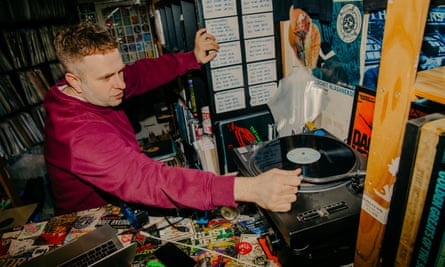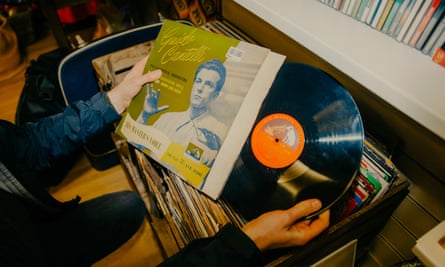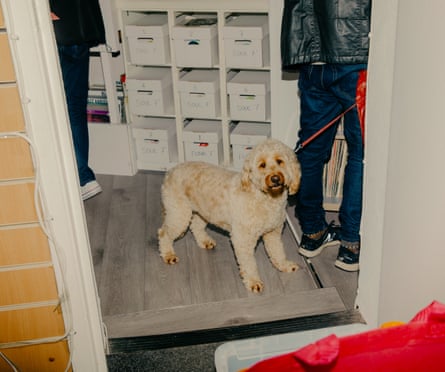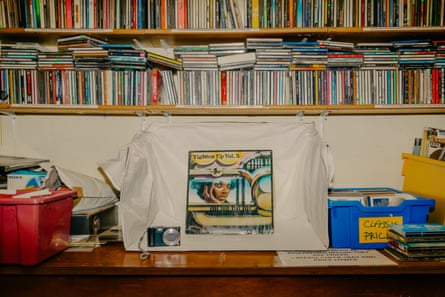Having dipped in and out of Record Store Day over the years, I have always dreamed that one day, while supplementing a collection founded on records I’d nicked from my dad’s garage, I’d track down the one and only 7-inch release by his 1960s band – called Sunny and the Cloudbursts – for a few pennies rather than a big wedge of notes.
So, to a soundtrack of screeching seagulls, I have come to Brighton, to continue searching for my vinyl holy grail and partake in a warm-up, my own bargain basement alternative to RSD, which falls this Saturday, bringing a dizzying avalanche of picture discs, rarities and Blur zoetrope reissues – albeit at a price. I want to see if there’s still joy and value to be found digging through the dusty secondhand crates. With Brighton home to upwards of a dozen record stores and 20 charity shops – which are increasingly wise to the true value of secondhand records – will today be the day I strike gold?
Disastrously, my musical tastes formed in the 1990s. With CD production at its height, this was a miserable era for record-buyers. Few were produced, meaning prices today are extortionate. Entering stalwart Brighton store Across the Tracks, I feel my wallet groaning as I pass first pressings of Oasis and Smashing Pumpkins lining the wall, all commanding three figures. Anna Doble, author of Connection Is a Song, a memoir charting the era, understands my indie woes. “I always keep an eye out for Pulp’s Different Class with the slide-in alternative covers,” she says. “My sister Claire and I always regret – painfully! – choosing the CD and cassette versions in 1995. Mint originals can sell for £700.”

A better strategy, she suggests, is to slide back a decade and look for David Bowie and Kate Bush. “Their vinyl is still everywhere because they were stars at the peak of vinyl production. Hounds of Love or Aladdin Sane can often be picked up for £7 to £15.” Richard Farnell, from Manchester’s Vinyl Exchange, agrees: “With Bowie, rather than searching for the orange RCA label originals, you could get the mid-80s black or green RCA International label reissues – for about half the price.”
That’s the sort of collector chat I’m wanting to hear. Placing Hounds of Love on the counter, I notice a group of teenagers digging away behind me. “The demographic has changed,” explains owner Alan Childs. “You still get collectors with money to spend, but the younger ones ask for Abba, Fleetwood Mac and Simon & Garfunkel.” It’s a similar story at Vinyl Exchange, says Farnell: “You might see a 17-year-old buying Rumours alongside Charlie XCX, Taylor Swift, the Smiths – and RUSH!”
Around the corner at Rarekind Records, which sells new and secondhand vinyl, owner Ewan Hood talks about balancing RSD with his customers’ needs and budgets. “Everyone is skint,” he says. “We know records aren’t essentials. But as a collector myself, and with my staff all being DJs, we want to give people the experience we had when we bought records.”
With its gig flyers, vinyl by the crateful and record-player, his store could not be more welcoming. It feels like somewhere you could settle into for the day. But Hood is visibly torn about RSD. “It’s done a lot for record shops,” he says. “So I’d never knock it. But when they cost £50, I don’t feel comfortable charging people that. I want to see them coming to the counter with a look that says they’ve found something they want at a good price.” I heed Hood’s advice and my knees give a percussive click as I crouch over the £3 crates. I find 90s solace in 12-inches by A Tribe Called Quest and Ed O.G. as well as a couple of folk curiosities, the joint cost of which he rounds down to a tenner.

Lewis Henderson, who co-runs Deptford Northern Soul Club in London and reissues 7-inches, explains why vinyl has become so expensive. “Since the war in Ukraine, the price of oil and PVC has skyrocketed.” Then there’s the pressing plants. “Major labels saw record sales going up and decided to get back in the game, mass-producing pop records. This had a knock-on effect for the smaller labels. And finally, you guessed it, the B word: Brexit.”
My last RSD purchase was Frank Wilson’s Northern Soul stomper Do I Love You (Indeed I Do), and at Uptight Records, a small soul, jazz and funk specialist store in nearby Hove, I’m hoping singles might offer a cheap way into the scene. “The thing to look for is the label,” Henderson has advised me. “Look for Shrine, Clear Hill and Arctic.” Bob Smith, Uptight’s owner, lets me down gently, saying: “Northern Soul flies out for big prices.” If I’m looking for value, he advises, “Go for greatest hits and classics.” He pulls out some Sam and Dave, the Brothers Johnson, Atlantic Starr and Gladys Knight. As Knight’s voice warms the air, Smith’s wife hands me a record and says: “If you like that, you’ll like this.” We play Knight’s It Takes a Whole Lotta Man For a Woman Like Me and I’m smitten.
Later, as I hunch over the turntable giving The Dude by Quincy Jones a spin, a customer asks: “Are you a DJ?” I tell him: “No, I’m a cheapskate.” He suggests checking out the vocalist on the record, Patti Austin. We find an Austin album and, at £4, it feels like a steal. The warmth isn’t just coming from the vintage Bower & Wilkins speakers: there’s a feeling of community here in Uptight, helped by the presence of a goldendoodle and a baby getting its first dose of space funk. There are strong RSD vibes too: inside a Parliament album, I find an original poster and limited-edition T-shirt transfer. Clutching half a dozen records, I head for the till thinking this is the kind of place where purse strings aren’t gripped tightly but rather ripped apart with gleeful abandon.

It’s no surprise, then, that the secondhand market is worth around the same as what new releases bring in. In the US alone, Discogs and eBay list more than 9m records. There’s an environmental upside, too: like any secondhand buying, reusing items has a positive green impact. With today’s technology of planned obsolescence, records are an outlier. They don’t degrade and rarely go to landfill, instead moving from collection to collection, or continuing their lives in charity shops.
Brighton seems to have a million. Navigating the cluster along Western Road, I thumb through crates stuffed with ephemera and oddities. There are pockets of 80s pop: Kim Appleby, Kylie Minogue and Jason Donovan. Then I find a clutch of Ringo Starr LPs for a fiver a go. One, titled French Dance Music, makes my heart flutter – until I see its crushing subline: “From the 16th century.” There are crates overflowing with the same crimped-hair crooners: the Rods, Cliffs and James Lasts.
Stories of hot finds are what keep a digger’s fingers keen. Farnell, of the Vinyl Exchange, heard about a rare punk single donated by a hospital radio station that’s now worth £600. Henderson found a 7-inch Since You Left by the Inticers at a car boot sale. Doble was tipped off about a delivery of mint Stereolab albums from a record store manager who just happened to be a friend of Lætitia Sadier, the band’s lead singer.
Most charity shops have wised up. They can’t afford to let a 7-inch worth £300 slip through their fingers for a quid. At an Oxfam in North Laine, the deputy store manager Kate tells me: “The cheap records are downstairs while the more valuable records, the ones that go on the Oxfam web store, are upstairs.” I’m invited into the inner sanctum, where hundreds of records are waiting to be tested on a portable Denver player then priced using Discogs and eBay (“so there aren’t any mistakes”).

The stock is diverse: Philly soul, Echo and the Bunnymen, some tatty Trojan pressings jostling with classical, acid house and Beatles. “Norman Cook once thumbed through them,” says Kate. He must have missed the copy of A Guy Called Gerald’s Voodoo Ray – we shake on it for a fiver. With everything priced to maximise returns, though, it feels like miracle finds will get ever rarer.
“There is a genre where expertise is thinner on the ground, though,” says Kate. “Classical.” Phil Hebblethwaite, author of Junk Shop Classical, began buying £1 classical records to discover new music cheaply. “The most prized records,” he says, “are early stereo recordings and first pressings on Decca, Columbia and His Master’s Voice.” Soloists, particularly violinists, command the highest value. “Leonid Kogan, Ruggiero Ricci, Alfredo Campoli, Johanna Martzy – first editions by any of that lot can sell for four figures.”
At the Chestnut Tree House children’s hospice shop, I wait for a man in a flat cap to finish inspecting George Michael and Andrew Ridgeley’s get-up on a Wham! 7-inch, before I begin sliding classical records from their sleeves. As I finish the first crate with a dissatisfied harrumph, Verity, one of the shop’s volunteers, offers me a tea and the chance to look out back. Immediately, I find a His Master’s Voice label, which ticks the boxes but isn’t worth much. Then – gold! Well, a slither of silver that denotes a Decca stereo first pressing. Discogs and eBay inform me that Mozart Complete Dances and Marches has sold for as much as £62. Thoughts of flipping it feel miserly, so I buy it as an affordable step into the sonic unknown.
After eight hours, I have barely scratched Brighton’s record surface. My feet are throbbing, my fingers feel like they’ve played 100 bass hooks – but I have snared a dozen records for around the cost of a single RSD release. Undoubtedly, RSD is great for artists, shops and labels, but if you want to keep supporting indies and charity shops, there are still great things to be found on a budget. Being open-minded, having time and bionic knees all help. Who knows – if I do this next year, I might even find that elusive Sunny and the Cloudbursts release.
Source: theguardian.com





















